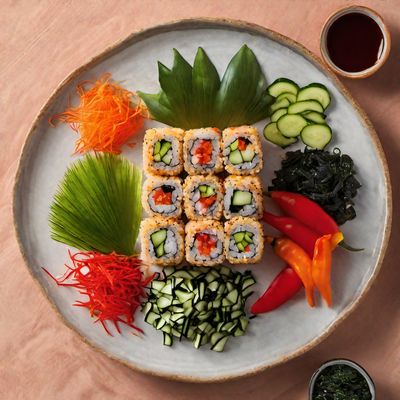
Recipe
Chinese-style Sushi Rolls
Dragon Rolls: A Chinese Twist on Sushi
4.8 out of 5
Sushi is a popular dish in Chinese cuisine, with its own unique twist. Chinese-style sushi rolls are typically larger and filled with heartier ingredients, such as cooked meats and vegetables. The rolls are often served with a variety of dipping sauces, adding an extra layer of flavor to the dish.
Metadata
Preparation time
45 minutes
Cooking time
20 minutes
Total time
65 minutes
Yields
4 servings
Preparation difficulty
Medium
Suitable for
Pescatarian, Dairy-free, Gluten-free, Nut-free, Low-fat
Allergens
Shellfish
Not suitable for
Vegan, Vegetarian, Paleo, Keto, High-fat
Ingredients
Chinese-style sushi rolls differ from traditional Japanese sushi in several ways. The rolls are typically larger and filled with cooked ingredients, rather than raw fish. Additionally, Chinese-style sushi often incorporates a variety of sauces and spices, giving the dish a more complex flavor profile. We alse have the original recipe for Sushi, so you can check it out.
-
4 sheets of nori seaweed 4 sheets of nori seaweed
-
2 cups (470ml) sushi rice 2 cups (470ml) sushi rice
-
2 cups (470ml) water 2 cups (470ml) water
-
1/4 cup (60ml) rice vinegar 1/4 cup (60ml) rice vinegar
-
1 tablespoon (15ml) sugar 1 tablespoon (15ml) sugar
-
1 teaspoon (5ml) salt 1 teaspoon (5ml) salt
-
1/2 cup (120ml) cooked shrimp, chopped 1/2 cup (120ml) cooked shrimp, chopped
-
1/2 cup (120ml) cooked chicken, shredded 1/2 cup (120ml) cooked chicken, shredded
-
1/2 cup (120ml) cucumber, julienned 1/2 cup (120ml) cucumber, julienned
-
1/2 cup (120ml) carrot, julienned 1/2 cup (120ml) carrot, julienned
-
1/4 cup (60ml) hoisin sauce 1/4 cup (60ml) hoisin sauce
-
1/4 cup (60ml) soy sauce 1/4 cup (60ml) soy sauce
-
1 tablespoon (15ml) sesame oil 1 tablespoon (15ml) sesame oil
-
1 tablespoon (15ml) sriracha sauce 1 tablespoon (15ml) sriracha sauce
Nutrition
- Calories: 350 kcal / 1465 KJ
- Fat: 3g (0.5g saturated)
- Carbohydrates: 70g (10g sugars)
- Protein: 12g
- Fiber: 2g
- Salt: 2g
Preparation
-
1.Rinse the sushi rice in cold water until the water runs clear.
-
2.In a medium saucepan, combine the rice and water. Bring to a boil, then reduce heat to low and cover. Cook for 18-20 minutes, or until the rice is tender and the water has been absorbed.
-
3.In a small saucepan, combine the rice vinegar, sugar, and salt. Heat over low heat until the sugar has dissolved.
-
4.Once the rice is cooked, transfer it to a large bowl. Add the vinegar mixture and stir to combine.
-
5.Lay a sheet of nori seaweed on a sushi mat. Spread a thin layer of rice over the nori, leaving a 1-inch border at the top.
-
6.Arrange the shrimp, chicken, cucumber, and carrot in a line down the center of the rice.
-
7.Roll the sushi tightly, using the mat to help you.
-
8.Repeat with the remaining ingredients.
-
9.In a small bowl, whisk together the hoisin sauce, soy sauce, sesame oil, and sriracha sauce.
-
10.Serve the sushi rolls with the dipping sauce on the side.
Treat your ingredients with care...
- Nori seaweed — Make sure to use fresh nori seaweed, as stale seaweed can be tough and difficult to roll.
- Sushi rice — Rinse the rice thoroughly before cooking to remove excess starch and prevent the rice from becoming too sticky.
- Hoisin sauce — Look for a hoisin sauce that is low in sodium and free of artificial flavors and preservatives.
- Soy sauce — Use a low-sodium soy sauce to reduce the overall sodium content of the dish.
- Sriracha sauce — Adjust the amount of sriracha sauce to your personal taste preferences.
Tips & Tricks
- Use a sharp knife to cut the sushi rolls into even slices.
- Wet your hands with water before handling the sushi rice to prevent it from sticking to your hands.
- Experiment with different fillings and dipping sauces to find your favorite flavor combinations.
- Serve the sushi rolls with pickled ginger and wasabi for an authentic Japanese touch.
- Use a sushi mat to help you roll the sushi tightly and evenly.
Serving advice
Serve the sushi rolls with the dipping sauce on the side, along with pickled ginger and wasabi. Garnish with sesame seeds and sliced scallions for added flavor and visual appeal.
Presentation advice
Arrange the sushi rolls on a platter, with the dipping sauce in a small bowl in the center. Garnish with sliced scallions and sesame seeds for added visual appeal.
More recipes...
For Sushi » Browse all
For Japanese cuisine » Browse all
More Japanese cuisine dishes » Browse all

Teppanyaki
Teppanyaki is a Japanese dish that consists of grilled meat and vegetables that are cooked on a hot griddle. The dish is typically served with...

Yudofu
Yudofu is a traditional Japanese dish made with tofu and kelp broth. It is a simple yet flavorful dish that is perfect for a cold winter day.

Enoki maki
Enoki Maki
Enoki maki is a Japanese dish made from enoki mushrooms wrapped in thinly sliced beef or pork. The dish is typically served as a side dish or...
More Chinese cuisine dishes » Browse all

Hújiāo bǐng
Hújiāo bǐng is a Chinese dish consisting of a savory pancake filled with scallions and spices.

Stir-Fried Spring Chicken with Chestnuts
This dish is a classic Chinese stir-fry that combines tender chicken with crunchy chestnuts and a savory sauce. It's a perfect dish for a quick...

Chinese Broccoli with Oyster Sauce
Chinese Broccoli with Oyster Sauce is a classic Chinese dish that is perfect for a quick and easy meal. It is made with Chinese broccoli, garlic,...











